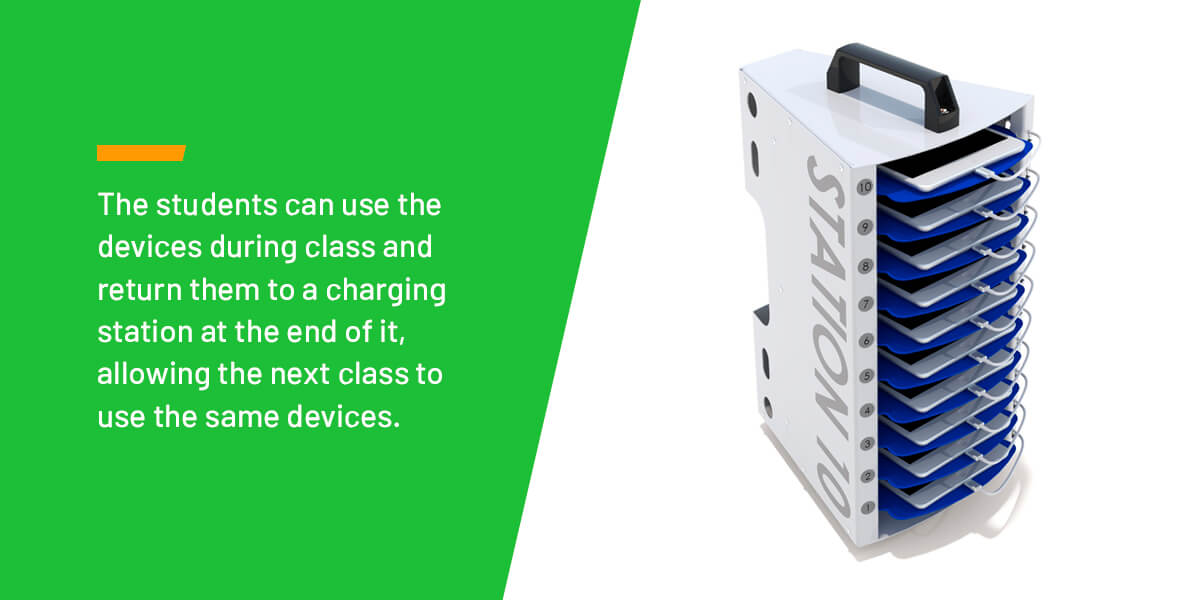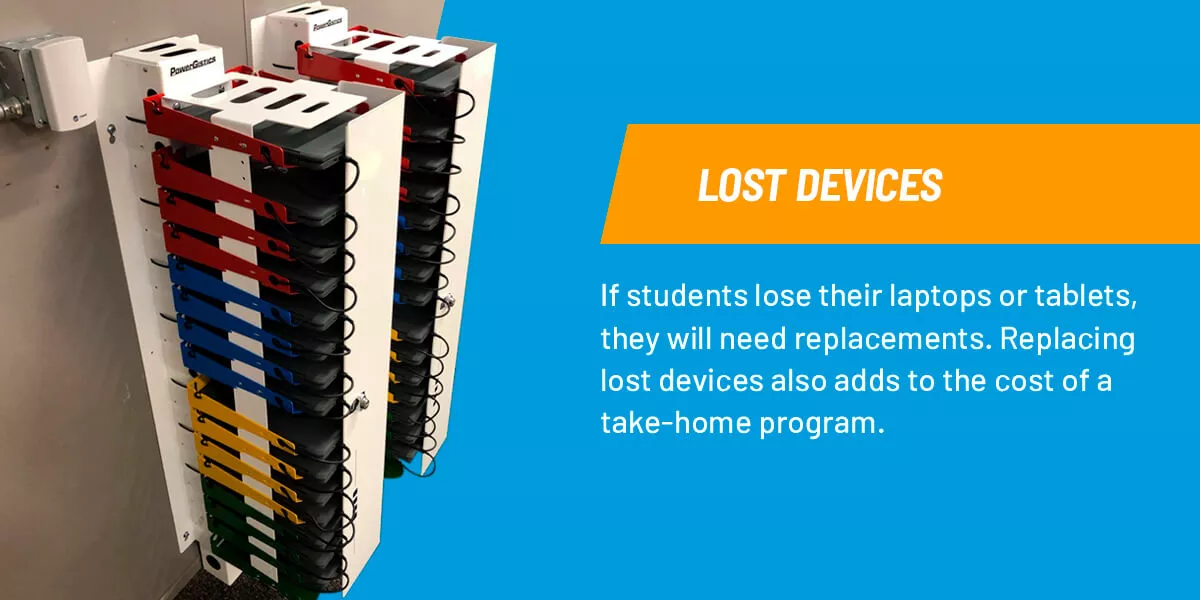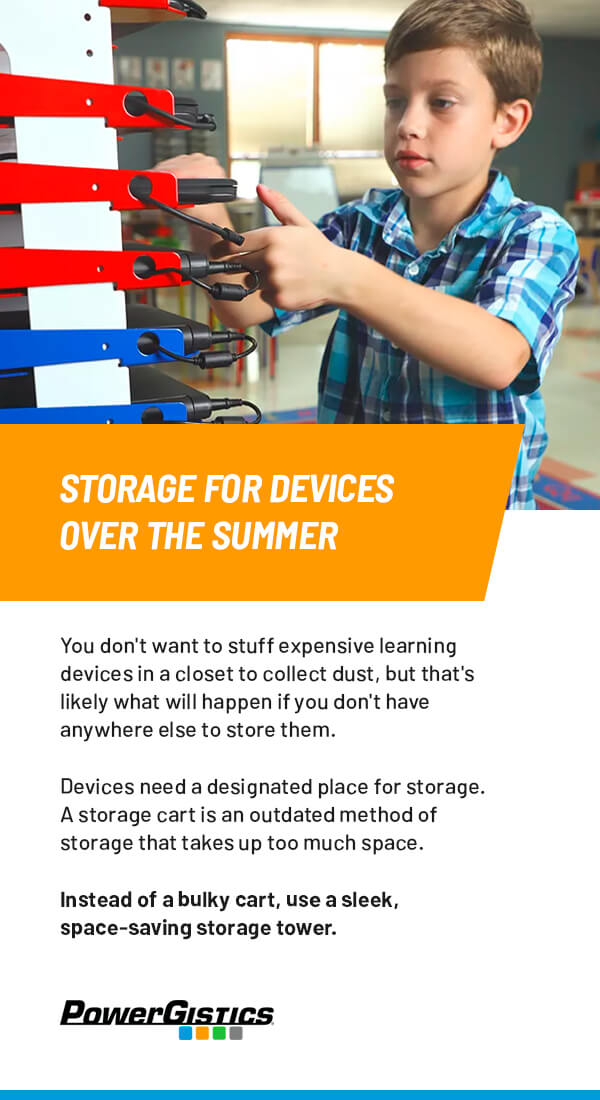10 Reasons Why Schools Should Not Use the Take-Home Technology Model
September 19, 2022
From elementary school to high school, classrooms worldwide are integrating technology use for education. Since school tablets, laptops, Chromebooks, iPads and other handheld devices have replaced computer labs in education, schools need to decide whether to allow students to take technology home. If schools choose not to use a take-home model, devices can stay in a specific classroom, move between classrooms or be rented out to a particular student to take with them throughout the day and return at the end.
Why Students Should Leave Laptops At School
What Is the Take-Home Technology Model?
The take-home technology model is a school program that assigns a device to each student. As with a textbook, the students can take these school iPads, Chromebooks, laptops or tablets home with them. Students are responsible for caring for their devices and bringing them to school every day.
When surveyed, 65% of teachers say they use digital student learning tools daily, and 53% of teachers say they would like to incorporate digital learning tools in their lessons. There many benefits to students using devices in schools, including:
- Creates a more engaging learning environment: Technology allows lessons to be more interactive, fun and engaging.
- Incorporates different learning styles: Technology often makes it easier for teachers to modify their lessons to account for different learning styles. Students can take notes more quickly in their preferred learning style.
- Improves collaboration: When students encounter technology-based issues or questions, they reach out to their peers or the teacher, which enhances collaboration and learning.
- Prepares students for the future: Students will become familiarized with computers and technology and develop various computer skills they can use in college or in their careers.
10 Reasons Not to Use the Take-Home Model
As you can imagine, students, teachers and administrators face many challenges when students take their devices home. Here are a few of the many reasons why schools should not use the take-home technology model:
1. High Costs
Only 45% of schools report having a computer for each student. For students to each have an individual device assigned to them, a school must purchase enough devices for every student at the school. If the school is small, this may not be a problem. However, if the school has 2,000 students, buying a $500 Chromebook for every student would cost $1,000,000. This cost will increase if the school buys extra devices to keep in the library or a central hub to loan out to students as needed.
A cost-effective solution is to purchase enough school Chromebooks, laptops, tablets or other devices for each student in the largest class size. The students can use the devices during class and return them to a charging station at the end of it, allowing the next class to use the same devices. A charging station will keep the devices updated, charged and ready to use. It makes it easier to keep track of them in the classroom and monitor their condition.

2. Forgotten Devices
While learning responsibility, students constantly forget things at home, such as books, pencils, lunches and school devices. There are simple solutions to forgotten books, pencils and lunches — students can share a book with a classmate, borrow a pencil from the teacher or buy lunch. However, there isn’t a simple solution to a forgotten device. Without a device, students can’t participate in any lesson that uses the device.
3. Lost Learning Time
Schools can prepare for students forgetting their devices at home by implementing a loaner program. The school can keep spare devices on hand in a central building like the library and have a system to allow students to borrow a device for the school day. Even though a loaner program enables students to participate in lessons, valuable learning time is lost while the student obtains the loaner device. That time adds up, especially if there are only 60 minutes per subject or class.
For example, if a student spends five minutes walking to the library, five minutes obtaining the loaner device and five minutes walking back, they’ve lost one-fourth of class time for a 60-minute class they won’t be able to make up. If the teacher waited for the student to return, all students lost 15 minutes of learning time.
4. Dead Devices
Even if students remember to bring their devices to school, they often forget to charge them. With the limited amount of available plugs in a classroom, a dead device is as good as a forgotten one. When students come to class with a dead device, there may not be an available outlet for them to charge it. The number of outlets in classrooms is limited. If the student can’t find an outlet, they will have to acquire a loaner device or miss out on the lesson.
5. Lost Devices
Worse than a forgotten or dead device is a lost device. If students lose their laptops or tablets, they will need replacements. If they can’t borrow a backup device immediately and the school must order a new one, students could spend days or weeks unable to participate in classes using these devices. Replacing lost devices also adds to the cost of a take-home program. And if students have to pay for lost devices themselves, they might not report them missing, causing them to lose even more class time.

6. Broken Devices
Broken devices take time to repair, especially if you have one for each student. The school’s IT Department is no stranger to repairing devices. Up to 15% of devices could break a year. When the school supplies one device per student, the number of broken devices could be quite high. More broken devices appear when students can take school-issued devices home with them.
Additionally, repairs take time. In some cases, a broken device may not be repairable, costing the school more money to replace it. If students can’t borrow a loaner tablet or laptop while IT services or replaces their device, they again miss out on many valuable lessons that require using the device.
7. Repair Fee Program
If the school doesn’t have a repair fee program, it will be responsible for all device repair and replacement costs. Student devices will inevitably require repairs at some point, so schools need a plan. Some schools offer parents a device protection plan and use a repair fee program. A repair fee program shares the cost of repairs with a student’s family. Parents can opt-in to a device protection policy and pay less when a repair is needed.
Parents who don’t opt-in to the device protection plan would be responsible for some or all of the repair costs. This model can help incentivize families to protect devices at home. If the school does not have a repair fee program, then the school is responsible for the cost of repairs, which could be thousands of dollars a year.
8. Students Keeping the Devices Over the Summer
Sometimes students are allowed to keep school laptops, Chromebooks, iPads, tablets and other devices over the summer. Schools usually let students keep devices to help them further their studies, but it’s unlikely students will study over the summer. Most will leave their devices untouched.
When students are allowed to keep devices over the summer, new problems arise. Unused devices may get misplaced, and used devices are more likely to break. Many students won’t return their devices when school begins in the fall. The school must spend more money repairing or replacing devices that could have been stored safely at the school over the summer. Additionally, teachers may need to adjust their lesson plans while students wait for the repaired or new devices to arrive, which slows learning.
9. Time Spent Collecting, Repairing and Returning Devices
Every minute in the classroom counts, especially if teachers only have 60 minutes a day to instruct a class or complete a lesson on a specific subject. You may want to do device checks every quarter or semester. Like textbook checks, you will inspect the devices and ensure they are in good working condition. However, these inspections take time. You will spend time collecting and returning the devices or sending them off to get repaired. It will probably take an hour or longer to do this, particularly if you want to return the devices to the students that same day.
If students take their devices home over the summer, teachers will be responsible for collecting and inspecting the devices when students return to school in the fall. Devices will be returned in various conditions, if they get returned at all. Many of these devices will have to be sent out for repairs, causing lessons to be adjusted or halted if there aren’t enough spare devices to distribute to the students.
10. Storage for Devices Over the Summer
You don’t want to stuff expensive learning devices in a closet to collect dust, but that’s likely what will happen if you don’t have anywhere else to store them. If students store their devices at home during the school year, there likely isn’t a place to keep them in the classroom. Then administrators will gather the devices at the end of the year only to place them in whatever closet or cupboard has room, which isn’t the best way to treat high-quality learning devices. Devices need a designated place for storage. A storage cart is an outdated method of storage that takes up too much space. Instead of a bulky cart, use a sleek, space-saving storage Tower.

Save Time and Money With PowerGistics
PowerGistics created the PowerGistics Tower when an IT director needed a charging station that took up minimal space and organized charging cables. PowerGistics designs, manufactures and engineers portable device storage and charging solutions for the classroom. You can customize the Towers to fit your needs:
- Customizable number of storage shelves: Towers come with eight, 12, 16 or 20 shelves to store devices. If you need more than one Tower, we recommend placing them on opposite sides of the room to prevent crowding around the Tower and to speed up deployment.
- Customizable color: The Towers come in red, blue, green, yellow and white. We also offer custom colors if you want to show off school spirit. Use the colorful shelves for grouping students.
- Optional cleaning caddy accessory: This add-on accessory hangs on the side of the Tower and can hold a sanitizing wipes container or a large hand sanitizer pump.
- Three installation options: The Towers can be wall-mounted, or placed on a Stand or Roller. A wall-mounted Tower can easily be mounted to a Stand or Roller if your deployment plan changes in the future.
The Towers also come with numerous benefits, including:
- Small vertical footprint: Two Towers take up less than half the square footage of one storage cart.
- Student managed: Students, not teachers, collect and return their assigned devices.
- Encourages social distancing: The Towers can be placed at opposite ends of the room to encourage social distancing and prevent crowding, helping prevent contagious illnesses such as COVID-19 and the flu.
- Individually assigned device shelves with colors and numbers: Students of all ages and abilities can easily find their devices by looking at the color and number.
- Single touch deployment: Students only touch their own devices, which reduces the spread of germs.
- Antimicrobial finish option for standard colors: The antimicrobial finish kills and stops the growth of bacteria, viruses and mold, which reduces the risk of them spreading.
- Student-proof cable management: Each device’s cable runs through a channel on the shelf with a pinch point so that cables will not get tugged or pulled out and will not reach another device or get tangled up.
- Maintenance-free cable management for IT: IT wires the cables once during the initial setup. No rewiring is required.
- No touch visual security checks: You can do a quick visual sweep of device inventory thanks to the open design.
- Quality aluminum construction and the open design: This keeps devices cool and prevents overheating while charging.
- Wireless updating: Wireless updating avoids using class time for essential updates and ensures every device stays up to date.
- Horizontal shelving: This reduces the risk of students dropping or damaging the devices while putting them away.
- Key locked: You will have a key to lock and unlock the cart, ensuring the devices are safe when put away.
- Made in the USA: PowerGistics proudly manufactures our charging Towers in Wisconsin.
- USB to USB-C cables: Our Towers come with USB to USB-C cables for a fast and easy setup.
- Optional USB-A power delivery unit: You can choose USB-A power delivery for a faster charge time.
- Lifetime Warranty and Underwriter Laboratories (UL) Certified: We stand behind our charging Towers with a lifetime warranty and UL certification.
Using a storage Tower can save you and your school’s IT staff time, money and space. You can unlock the cart at the beginning of the day and not worry about it until the end of the day. After class, you can inspect and inventory the devices before locking them up and heading home. And you can rest assured that all the devices will be fully charged the next time you need them. Contact PowerGistics today to request pricing or view and learn more about our storage Towers.
Further Reading
5 Ways to Save Time in the Classroom
5 Ways Technology Can Improve Your Classroom
How to Create a Technology Plan for Your School
How to Maximize the Battery Life of School Devices
Skills to Look for in Your School’s Director of Technology

